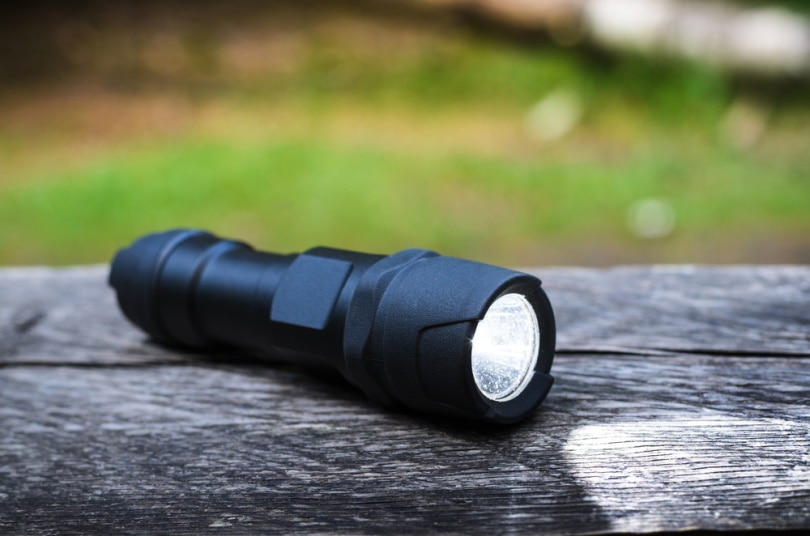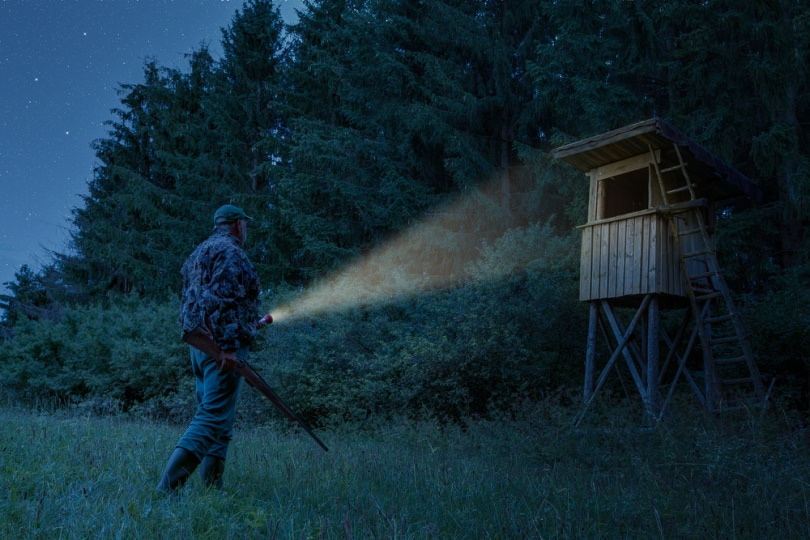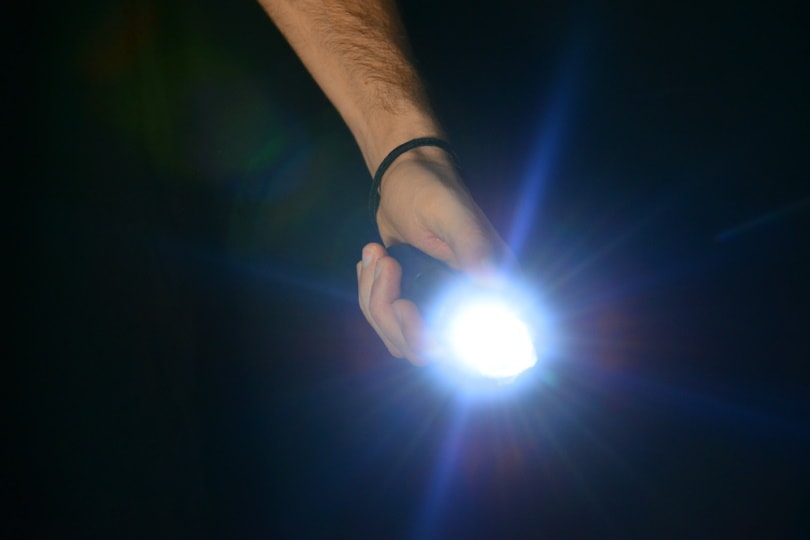How Does a Flashlight Work? What Are Its Parts?
Last Updated on

When you turn a flashlight on, it can feel like magic. But inside the device that you’re holding, there’s a sound scientific process that’s turning electricity into light that you can use.
So, how exactly does a flashlight work, and what are all of its different components? It seems like it’s a complicated thing, but it’s simpler than you might think.
Here, we walk you through the basics of a flashlight!

How Does a Flashlight Work?

Flashlights work with the same principles of electricity as anything else. The electrons run between the negative and positive electrodes of the battery, and when they reach the bulb, they generate heat at the filament, and this heat generates light.
When the light is off, it creates an opening in the circuit, which cuts the circuit. With an incomplete circuit, everything turns off. When the light is turned on, it completes the circuit again, creating light!
Of course, a flashlight needs to direct that light somewhere, and that’s the job of the reflector. The reflector is a plastic part covered with aluminum, and it redirects light toward the front of the flashlight.
These are the basics of how a flashlight operates; every other component in a flashlight is there to protect the flashlight itself or simply make it easier to hold and use.
How Does an LED Flashlight Work?
LED flashlights follow the same basic principles as any other flashlight, except they use different types of “lamps,” or bulbs.
An LED is simply a small diode wrapped in epoxy, and the epoxy glows when electricity runs through it. They’re extremely energy efficient and long lasting, but you typically can’t swap out LEDs. So, when an LED flashlight breaks, you’ll need to purchase an all-new flashlight instead of just swapping out the bulb.

What Are the Parts of a Flashlight?
A flashlight can be broken down into seven different parts, regardless of the type that you’re using. Let’s go over each part and what it does.
- Case: The case is what holds everything else in the flashlight. It can come in tons of shapes and sizes depending on the flashlight.
- Switch: When you turn the flashlight on and off, you do it with the switch. It can be a slide lever, a push button, or something else entirely. What makes it a switch is that when you activate it, you’re completing or disconnecting the circuit to turn the flashlight on and off.
- Contacts: The contacts in a flashlight are usually thin, coiled, metal strips inside the case. This is the component that you move and connect or disconnect when you’re activating the switch. When the contacts touch, you’re completing the circuit and turning on the flashlight. When they stop touching each other, you’re breaking the circuit and turning the flashlight off.
- Battery: There are tons of different power sources that your flashlight can use, but they all serve the same function: to provide electricity to the lamp. You can have a flashlight without a battery, but you’ll have to plug it directly into a power source to use it. Since you typically want to transport a flashlight and use it on the go, a battery is an essential component to hold the electricity until you’re ready to use it.
- Reflector: The reflector directs the light in a flashlight in a specific direction. It’s usually a plastic part with an aluminum coating, and this reflects and bounces the light around until it leaves the part going in the right direction. Without a reflector, light would travel in every direction inside a flashlight, and you wouldn’t be able to see very far.
- Lamp: Your flashlight needs a light source, and whether it uses an incandescent bulb or an LED, it’s called a lamp. Some people commonly refer to the lamp as the bulb, but in the case of an LED flashlight, there’s no “bulb” inside.
- Lens: The lamp inside your flashlight is a highly breakable and sensitive component, which is why it’s protected with a lens. This is usually a plastic covering at the front of the flashlight, and it keeps things from smashing into the lamp and breaking it. You also don’t want to get the lamp wet, and the lens often provides a waterproof barrier for additional protection.

What Kind of Circuit Does a Flashlight Use?
Flashlights use a classic example of a “simple” series circuit, since there aren’t many different components that it flows through. Sometimes, a flashlight with multiple batteries will have them in a parallel circuit, but the flashlight itself still uses a series circuit.
Using a series circuit enables you to turn off the flashlight by disconnecting just one part of the circuit, which is exactly what you want with an on/off switch!
- You might also like: 8 Best Police Flashlights: Reviews, Top Picks, And Buyer’s Guide

Final Thoughts
While flashlights are incredibly useful products, few people take the time to understand how they work. Now that you know more about them, you can truly appreciate how these simple little devices have revolutionized the way that humans have lit up the world!
Related Read:
- How to Clean Battery Acid From a Flashlight in 3 Steps
- When Were Flashlights Invented? History of the Flashlight
- Can You Take a Flashlight on a Plane? Does It Depend on Type?
Featured Image Credit: OgnjenO, Shutterstock
About the Author Robert Sparks
Robert’s obsession with all things optical started early in life, when his optician father would bring home prototypes for Robert to play with. Nowadays, Robert is dedicated to helping others find the right optics for their needs. His hobbies include astronomy, astrophysics, and model building. Originally from Newark, NJ, he resides in Santa Fe, New Mexico, where the nighttime skies are filled with glittering stars.
Related Articles:
How to Clean a Refractor Telescope: Step-by-Step Guide
How to Clean a Telescope Eyepiece: Step-by-Step Guide
How to Clean a Rifle Scope: 8 Expert Tips
Monocular vs Telescope: Differences Explained (With Pictures)
What Is a Monocular Used For? 8 Common Functions
How to Clean a Telescope Mirror: 8 Expert Tips
Brightfield vs Phase Contrast Microscopy: The Differences Explained
SkyCamHD Drone Review: Pros, Cons, FAQ, & Verdict
